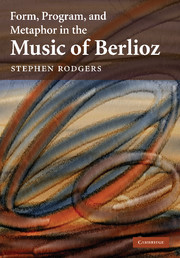Book contents
- Frontmatter
- Contents
- Music examples
- Figures
- Acknowledgments
- 1 Introduction
- 2 Preliminary examples and recent theories
- 3 Form as metaphor
- 4 Mixing genres, mixing forms: sonata and song in Le Carnaval romain
- 5 The vague des passions, monomania, and the first movement of the Symphonie fantastique
- 6 Love's emergence and fulfillment: the Scène d'amour from Roméo et Juliette
- 7 Epilogue
- Notes
- Bibliography
- Index
2 - Preliminary examples and recent theories
Published online by Cambridge University Press: 27 June 2009
- Frontmatter
- Contents
- Music examples
- Figures
- Acknowledgments
- 1 Introduction
- 2 Preliminary examples and recent theories
- 3 Form as metaphor
- 4 Mixing genres, mixing forms: sonata and song in Le Carnaval romain
- 5 The vague des passions, monomania, and the first movement of the Symphonie fantastique
- 6 Love's emergence and fulfillment: the Scène d'amour from Roméo et Juliette
- 7 Epilogue
- Notes
- Bibliography
- Index
Summary
Simple cycles
One of the best-known passages in Berlioz's output is the Dies irae from the last movement of the Symphonie fantastique. It is a harrowing stretch of measures, as stark and severe as anything in nineteenth-century music (see Ex. 2.1). Funeral bells cut short the witches’ sabbath tune, which has barely even begun, and draw us deeper into the nightmare of the symphony's protagonist. Then the familiar Dies irae tune enters, ominously and in dotted half notes, punctuated by the bells at irregular intervals. The theme completed, it begins again, twice as fast, in dotted quarter notes, and then once more, feverishly and faster still, in alternating quarters and eighths. (The numbers 1, 2, and 3 in Ex. 2.1 indicate where each statement of the theme begins.)
This is a varied strophic form par excellence and only one of the most recognizable among countless in Berlioz's music. Granted, it is very short – part of a movement, not a movement as a whole. Yet for that reason it makes for a good starting point. It is a miniature example of the type of large-scale form that will be addressed in later chapters. Looking at it can give us a sense of what Berlioz's varied strophic forms look like and how they are related to the poetic and dramatic sentiments that are his very raison d’être. Below I focus on theories of circular and rotational form and comments by Berlioz scholars about his penchant for strophic variation.
- Type
- Chapter
- Information
- Form, Program, and Metaphor in the Music of Berlioz , pp. 11 - 38Publisher: Cambridge University PressPrint publication year: 2009



